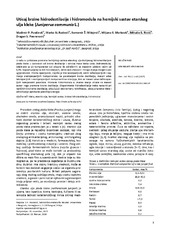Приказ основних података о документу
Influence of hydrodistillation rate and hydromodule on chemical composition of juniperus communis l. Essential oil
| dc.creator | Pavićević, Vladimir | |
| dc.creator | Radović, Marko N. | |
| dc.creator | Milojević, Svetomir | |
| dc.creator | Marković, Miljana S. | |
| dc.creator | Ristić, Mihailo S. | |
| dc.creator | Povrenović, Dragan | |
| dc.date.accessioned | 2021-03-10T13:33:55Z | |
| dc.date.available | 2021-03-10T13:33:55Z | |
| dc.date.issued | 2017 | |
| dc.identifier.issn | 0367-598X | |
| dc.identifier.uri | http://TechnoRep.tmf.bg.ac.rs/handle/123456789/3739 | |
| dc.description.abstract | Essential oils are aromatic, volatile, complex mixtures of various compounds, mainly hydrocarbons (monoterpene and sesquiterpene) and some oxygenated hydrocarbons. Juniper berry essential oil has wide application and high commercial value due to its considerable antimicrobial activities. It is used in medicine, food, cosmetic and pharmaceutical industry and veterinary medicine. Generally, it is obtained by hydrodistillation, technique for the extraction of substances which do not mix or mix very poorly with water and are unstable at their boiling temperatures. It provides high quality of essential oil and also represents a relatively simple, safe and environmentally friendly process. The variations in the chemical composition of the essential oil obtained from juniper berries at various distillation rates (3, 6 and 8 ml/min) and various mass ratio juniper berries-water (hydromodules -1:3, 1: 4 and 1: 5) are presented in this paper. It is important to emphasize that the variations made influence only in quantitative (mass%), but not in qualitative chemical composition (no differences, same 58 components were detected in all experiments). To reflect those effects, only 23 identified components with the content higher than 0.5 mass% were selected, constituted 95-96 mass% of the essential oils. The major constituents of the essential oils were monoterpenes (67.39-71.00 mass%), followed by sesquiterpenes (21.64-24.54 mass%), while the oxygenated monoterpene (1.54-2.42 mas.%) and oxygenated sesquiterpenes (0.89-1.46 mass%) were much less present. According to volatility, the high volatile (boiling point 153-167 degrees C) components are the main constituents of the essential oils (61.69-63.81 mass%), followed by the low volatile (boiling point 252-288 degrees C) components (22.57-26.04 mass%), and the least present medium volatile (boiling point 173-212 degrees C) components (7.24-9.61 mass%). The variations in the mass content of the essential oil at various distillation rates showed clear general trends for all hydromodules (with exceptions at some components). With the increasing of distillation rate, mass% of high and medium volatile components decreased, while mass% of low volatile components increased. This is caused by higher extraction of low volatile components at high distillation rate, which resulted the increasing of their mass%. The variations in the mass composition of the essential oil at various hydromodules showed less expressive trends for all distillation rates. That means it has much less influence on the mass composition than the variation of distillation rate. Therefore, experiments at various distillation rates should be continued in combination with the fractionation of the essential oil by simultaneous hydrodistillation and rectification, including the effects of preparation procedures of juniper berries and defining of optimal energy consumption, i.e., optimal time period of hydrodistillation. | en |
| dc.publisher | Savez hemijskih inženjera, Beograd | |
| dc.rights | openAccess | |
| dc.rights.uri | https://creativecommons.org/licenses/by-nc-nd/4.0/ | |
| dc.source | Hemijska industrija | |
| dc.subject | Juniper | en |
| dc.subject | Essential oil | en |
| dc.subject | Chemical composition | en |
| dc.subject | Hydrodistillation rate | en |
| dc.subject | Hydromodule | en |
| dc.title | Influence of hydrodistillation rate and hydromodule on chemical composition of juniperus communis l. Essential oil | en |
| dc.type | article | |
| dc.rights.license | BY-NC-ND | |
| dc.citation.epage | 10 | |
| dc.citation.issue | 1 | |
| dc.citation.other | 71(1): 1-10 | |
| dc.citation.rank | M23 | |
| dc.citation.spage | 1 | |
| dc.citation.volume | 71 | |
| dc.identifier.doi | 10.2298/HEMIND151119011P | |
| dc.identifier.fulltext | http://TechnoRep.tmf.bg.ac.rs/bitstream/id/1564/3736.pdf | |
| dc.identifier.scopus | 2-s2.0-85016214325 | |
| dc.identifier.wos | 000397234900001 | |
| dc.type.version | publishedVersion |

